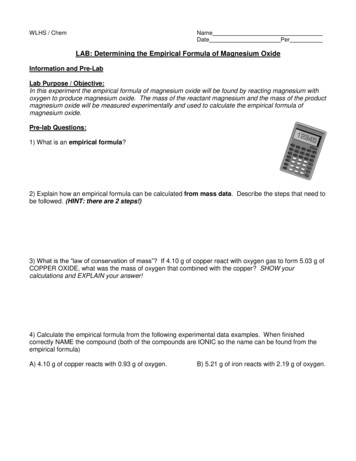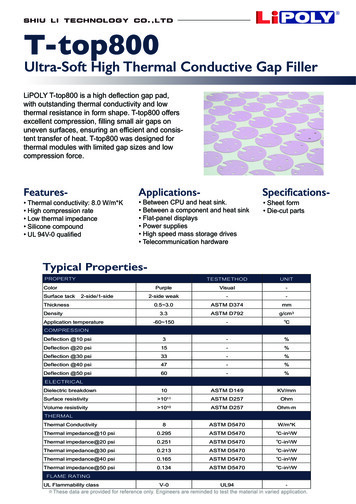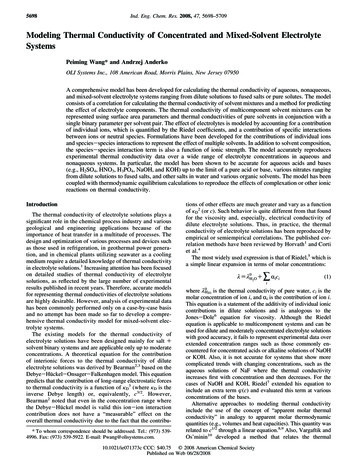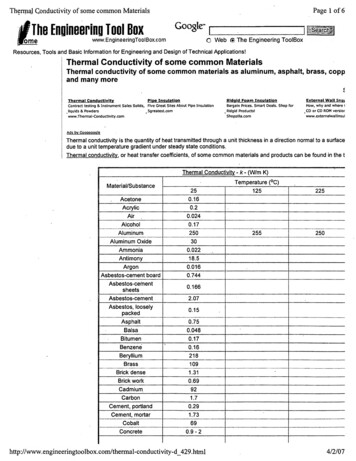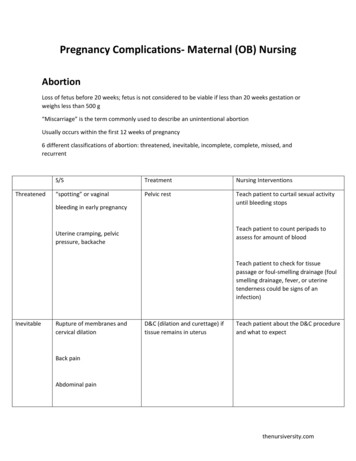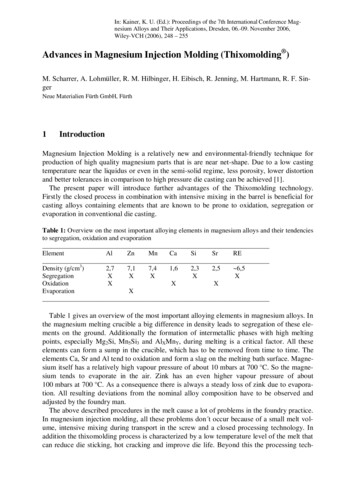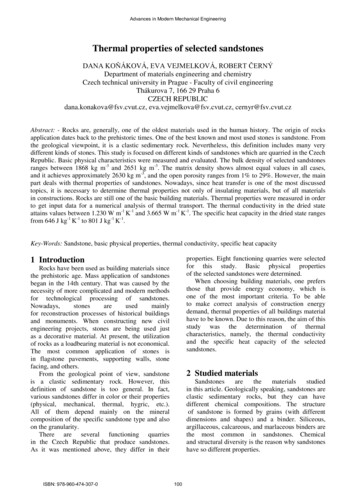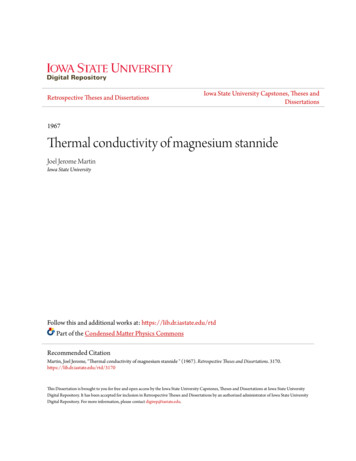
Transcription
Retrospective Theses and DissertationsIowa State University Capstones, Theses andDissertations1967Thermal conductivity of magnesium stannideJoel Jerome MartinIowa State UniversityFollow this and additional works at: https://lib.dr.iastate.edu/rtdPart of the Condensed Matter Physics CommonsRecommended CitationMartin, Joel Jerome, "Thermal conductivity of magnesium stannide " (1967). Retrospective Theses and Dissertations. 3170.https://lib.dr.iastate.edu/rtd/3170This Dissertation is brought to you for free and open access by the Iowa State University Capstones, Theses and Dissertations at Iowa State UniversityDigital Repository. It has been accepted for inclusion in Retrospective Theses and Dissertations by an authorized administrator of Iowa State UniversityDigital Repository. For more information, please contact digirep@iastate.edu.
This dissertation has beenmicrofilmed exactly as received67-8925MARTIN, Joel Jerome, 1939THERMAL CONDUCTIVITY OF MAGNESIUM STANNIDE.Iowa State University of Science and Technology,Ph.D., 1967Physics, solid stateUniversity Microfilms, Inc., Ann Arbor, Michigan
THERMAL CONDUCTIVITY OF MAGNESIUM STANNlDEbyJoelJerome Mart i nA Dissertation Submitted to theGraduate Faculty in Partial Fulfillment ofThe Requirements for the Degree ofDOCTOR OF PHILOSOPHYMajor Subject:PhysicsA p p r o v e d:Signature was redacted for privacy.n Charg of Major WorkSignature was redacted for privacy.H e a d f hf'jha j r D e p a r t m e n tSignature was redacted for privacy.De l of Grâbuate CollegeIowa State UniversityOf Science and TechnologyAmes, Iowa1967
TABLE OF perties o f Mg2Sn1B.Purpose of this Investigation5THEORY6A.Theory of Thermal Conductivity of Semiconductors6B.Seebeck Effect17EXPERIMENTAL SULTS AND DISCUSSION4lA.Thermal Conductivity Results41B.Thermal Conductivity Discussion41C.Seebeck Coefficient Results and Discussion59D.Conclusions66E.Future Work67V.LITERATURE CITEDVI .ACKNOWLEDGEMENTSVII.viAPPENDIX68.7273
LIST OF TABLESPageTable 1 .Sample characteristics25Table 2.Relaxation time parameters49Table 3.Diffusion Seebeck coefficient parameters62Table 4.Sample experimental data73Table 5.Thermal74conductivity and Seebeck coefficient results
I VLIST OF FIGURESPage1Crystal2Electrical resistivity, p,t i v i t y samples34structure o f Mg2Sn2of the thermalconduc 22Hall coefficient, R, of the thermalsamplesconductivityHall c o e f f i c i e n t , R, and e l e c t r i c a lresistivity,23P, o f M g 2 S n s a m p l e s K - 1 1 a n d K - 1 3 a t l o w t e m p e r atures24Sample holder276ASample heat sink clamp296BThermometer clamp295789Block diagram ofratusthe thermalconductivity appa 33Percentage correction of the measured thermalconductivity values calculated from the last twoterms of Equation 6640Thermal42conductivity results10The thermal resistance o f Mg2Sn above 100 K4411T h e t h e r m a l c o n d u c t i v i t y of M g 2 S n c a l c u l a t e d f r o mthe Callaway theory with the size of the samplecalculated from the Casimir theory47The figure shows the magnitude o f the correctionterm in the Callaway theory48The thermal conductivity o f Mg2Sn calculated fromthe Callaway theory with the size of sample K-13adjusted to f i t the data at 4.2 K51The thermal conductivity calculated with bounddonor electron phonon scattering for samples K-13and K-13 B is shown56The thermal conductivity calculated with bounddonor electron phonon scattering for samples K-1 Iand K-15 i s shown5712131415,
VpageFigure 16.The absolute Seebeck coefficient for thediffusion range is shown60Figure 17.The phonon drag Seebeck coefficient i s shown64Figure 18,The total Seebeck coefficient a ttures i s shown65low tempera
ViABSTRACTThe thermalc o n d u c t i v i t y o f s e v e r a l n - t y p e M g g S " s a m p l e s was m e a s u r e dfrom 4.2 to 300 K.The samples had uncompensated donor concentrationson the order of 2 x 10 donors/cm .t i v i t y showed a T lattice thermalAbove 150 K,the thermalconduc temperature dependence which is characteristic ofconductivity.The theory for high temperature thermalconductivity of Leibfried and Schloemann i s In agreement with our results.The b i p o l a r e l e c t r o n i c c o n t r i b u t i o n was estimated t o be U % o f the t o t a lthermalconductivity at 300 K.Below 100 K, the data were analyzed i nterms of the Callaway theory by combining the relaxation times for phononphonon scattering,isotope scattering, boundary scattering and bounddonor electron-phonon scattering.Above the thermali t was necessary t o retain the exp(-0/aT)conductivity maximumterm in the phonon phononscattering process to obtain the correct temperaturedependence.Thecalculation i n the neighborhood o f the thermal conductivity maximum I n d i cated t h a t the only point defect scattering present i n the samples wascaused by the isotopes o f Mg and Sn.At 4 K 'the data showed a smallersize dependence than the theory predicted i f only boundary scatteringwas Included.in addition, the measured values were about half of thecurves calculated with only boundary scattering.This r e s u l t was ex plained in terms of an additional phonon scattering caused by the bounddonor electrons.With t h i s mechanism I t was possible t o account f o r thesize difference and the difference In doping in the samples.As an aux i l i a r y experiment the Seebeck c o e f f i c i e n t was measured a t the same time asthe thermal conductivity.The phonon drag contribution to the Seebeckc o e f f i c i e n t shows a T ' temperature dependence from 30 t o 100 K.
I.A.I.Properties o f Mg2SnCrysta1 structureMg2Sn i s aI I -1V compound semiconductor o f the Mg2Xbe S i , Ge, Sn or Pb.ture.Figure 1 shows the cubic u n i t c e l l o f Mg2Sn.(deg)"'family where X canThe Mg2X compounds c r y s t a l l i z e i n theparameter of 6.7625 A at 26 C2.INTRODUCTION(49).Shanks'Pluorite struc Mg2Sn has a l a t t i c efound a value of 9.S x 10 for the temperature coefficient of the lattice parameter at 300 K.Energy gapWinkler (53) determined an energy gap o f (0.36 - 3 x 10 \) eV from h i sr e s i s t i v i t y , Hall effect and Seebeck effect measurements.B l u n t et a L -found an energy gap o f 0.33 eV from t h e i r Hall e f f e c t data.Nelson (40)found a gap of 0.36 eV from his Hall coefficient measurements.gap o f 0.34 eV was determined from Hall(&)An energye f f e c t m e a s u r e m e n t s b y L a w s o n e t 1. (34)T h e o p t i c a ] m e a s u r e m e n t s o f B l u n t e t a] . ( 6 ) y i e l d e d a n e n e r g y g a p o f0.33 eV a t 5 K; they found that the energy gap decreased as the tempera ture increased.The o p t i c a l a b s o r p t i o n measurements o f Lawson e aj .gave an energy gap o f 0.18 eV a t 294 K.(34)They found that i f their measure ments were interpreted i n terms of indirect transitions the energy gap in creased as the temperature increased.Lipson and Kahan (37)interprett h e i r optical absorption data i n terms o f an energy gap o f about 0.18 eV a t'shanks, H. R.,tion.1966.Iowa State University, Ames,Iowa.Private communica
2O Sn ATOMoMg ATOMFigure 1.Crystal structure of Mg2Sn
30 K and a temperatu re dependence of -1.7 x 10" eV/deg.At the present time,the energy gap o f Mg2Sn i s not understood.A gapo f about 0.36 eV seems t o r e s u l t from e l e c t r i c a l measurements, but a gap o fabout 0.18 eV seems t o r e s u l t from o p t i c a l measurements.3.Mob i l i t yW i n k l e r ( 5 3 ) , Ge i c k e t aj .(21) and Lichter (36)found that the mobil-2 5i t i e s of both holes and electrons have a temperature dependence of Tthe intrinsic range (T 300 K).Thet r i b u t e d t o o p t i c mode s c a t t e r i n g .intemperature dependence was a t The r a t i o o f the electron mobility tothe hole m o b i l i t y i n the i n t r i n s i c range was found t o be 1.20 - 1.25 byLipson and Kahan(37) and 1.23 by B l u n t e t aj .(6)The electron mobilityat 300 K is about 300 cm \/"'sec"'.B l u n t e t a] .(6)found that the mobilities of both electrons and holeshad a temperature dependence of T between 80 and 200 K.l y , G e i c k e t a l .(21) and Lichter(36)as T"'* for temperatures below 300 K.More recent found that the hole mobility variesThe T ' ' dependence wasinter preted i n terms o f acoustic mode s c a t t e r i n g .4.Effect ive massesLipson and Kahan (37) have reported the most recent e f f e c t i v e massvalues.They found that the conductivity effective masses are 0.15 m and0.10 m for electrons and holes respectively; and that the density of stateeffective masses are 1.2 m and 1.3 m f o r electrons and holes respectivelywhere m is the free electron mass.
k5.Elect ronIc st ructureLipson and Kahan(37) have suggested t h a t the band s t r u c t u r e o f Mg2Snconsists of a t r i p l y degenerate valence band located a t k 0 and conduc t i o n band minima located away from k 0.ments o f Umeda(50)The magneto resis tance measure indicate that the conduction band o f Mg2Sn consists o fe l l i p t i c a l energy surfaces along the 100 direction of the reci proca1lattice.Grossman and Temple (15) made piezo-resistance measurements whichalso indicated conduction band minima along the 100 directions.6.Dielectric constantMcWilliams and Lynch (38) have determined the high frequency dielec t r i c constant of Mg2Sn; they found 17.0.Their data indicate thatthe transverse o p t i c mode l a t t i c e frequency i s 5 . 6 x 10i n f r a r e d r e f l e c t i v i t y d a t a o f G e i c k e t aj .(21 )]7-1sec" .The f a r -indicate thathas a constant value of 7. below 300 K and increases t o 8.2 at 500 K;Eq is the static dielectric constant.7.Elastic properti esD a v i s e t(17) have measured the sound velocities of Mg2Sn,Theyfound f o r the 100 direction, Cg 4.78 x lO cmsec ' and c 3.19 x5-110 cmsecwhere c i s the longitudinal wave sound velocity and c i s thetransverse wave sound velocity.They have calculated the phonon dispersioncurves on the basis of several models.They found that the dispersioncurves calculated from a shell model gave a best f i t t o the Debye tempera ture versustemperature curve obtained from the heat capacity measurementsof Jelinek et al.(29)
58.Therma1 propert i esThe heat capacity o f Mg2Sn has been measured from 5 t o 300 K byJelinekaj .(29)They report a Debye temperature o f 388.4 K a t 1 K.The Seebeck effect has been measured by Boltaks (7) and by Winkler(53)from 80 K to 600 K.Several o f Winkler's samples showed a signchange i n the Seebeck coefficient near 150 K which indicates that theyfwere p-type; a l l o f his result showed a positive temperature c o e f f i c i e n tat low temperatures.effectAigrain ( I ) has measured the thermomagnetoe1ectrici n Mg2Sn; he found that the e f f e c t i v e mass of the holes i s 0.14 m .Busch and Schneider (9) have measured the thermalMg2Sn from 73 t o 473 K.conductivity ofTheir results did not indicate any electronic"contribution to the thermal conductivity.B.Purpose of this investigationThe purpose o f t h i s investigation was t o measure the low temperaturethermal conductivity o f Mg2Sn.The relaxation time f o r a number of phonons c a t t e r i n g mechanisms that may be present have been worked out by a numberof authors.Comparison of the experimental data with the values calculatedfrom the theory of Callaway (10) allows one t o test the magnitude of thevarious phonon relaxation times.A simple modification of the apparatus allowed the Seebeck c o e f f i c i e n t t o be measured a t the same time as the thermal c o n d u c t i v i t y .TheSeebeck data can be interpreted in terms of the existing theories of trans port properties of semiconductors,in addition,of the Seebeck coefficient providesinformation on electron-phonon inter actions .the phonon-drag component- -
6I 1.A.1 .THEORYTheory of Thermal Conductivity of SemiconductorsSepa r a t i o n o f l a t t i c e and e1ect roni c componentsi n a semiconductor, heat may be carried by phonons (quantized l a t tice vibrations) and by charge carriers (electrons and holes).The totalthermal conductivity, K, can be separated into an electronic component.Kg, and a l a t t i c e component, Kp, as followsK Kg Kp .(])Equation 1 holds i f the interaction between the electrons and thephonons is small.The validity of Equation 1 has been discussed by Drab ble and Goldsmid (18).assume that Equation 12.For the purposes o f t h i s discussion, we shallis valid.Elect roni c the rma1 conduct i v i t yFollowing Smithtimes of Herring (26)(4?) but using the method of averaging relaxationthe electron current density, J, in a semiconductorwith an applied electric field, ., and temperature gradient,,J n e r?—cemg TdT/dx,isô Ef' "] v t ne dT v ET n n,ôx\ T / v Tmg dx v , (2)where n i s t h e number per u n i t volume o f e l e c t r o n s , mg i s the e f f e c t i v emass,e is the magnitude of the electronic charge, T is the absolutetemperature, Ef i s the Fermi level, E is the energy of the electronmeasured from the bottom of the conduction band, v is the electron veloc i t y and Tis the relaxation time.the quantity () is given byFor a non-degenerate semiconductor,
(where f ) ( )rf E2dEf E dE:3a)exp (-E/kT).Often, T may be expressed asT AE-s(3b)Then Equation 3a gives:where (x) v T / v Et / AkT v E T / Ak TARl-i!)- P[ -(3c)i s t h e gamma f u n c t i o n .The electron heat current density,isnmg"-ôx \ T/-' dT v E t Tmg dx (4)The thermal conductivity i s measured under the condition of zero electriccurrent.Therefore, Equation 1is solved for with J 0, and theresult is substituted into Equation 4 to given v E t v T - v Et 2 V V T meTdTdx(5)or'dT"Since the electrical V E T V T - V ET 2mgT v v T conductivity a IL ë mpKewhere (%)(6), we have Vo T ,(7)
8f2 222 V E T y T - v ET -2k, 2 T 2 .yZ rt 2(8)orK' ee -7 )'lf2l - s / (l eFor the case o f acoustic mode scattering, sa simple meta].Equation 8 gives(T T . (9)—, we f i n d - the Lorenz number,-C. 2.For2IIn a non-degenerate p-type semiconductor,i f we assume T AE Sthe hole current is given byÔ /Efl./5, \ 1 dT (10)w h e r e p i s t h e n u m b e r o f h o l e s p e r u n i t v o l u m e , j. i s t h e h o l e m o b i l i t y t v 2 / v 2 ) a n d Ef A E - E w h e r e A Eis the energy gap.Similarily, the hole heat current density is given byQ. Pl h ( 2 - ' jkT l e -[ t — I \ k ( - - s ' ''— i r a " ( i - ) ! }(11)The second term in Equation I I represents the transport of the recombina tion energy of electrons and holes.Hence,I t is zero for zero hole current.the electronic contribution to the thermal conductivity of a p-type sample is - (f - j( (12)I f we are dealing w i t h an i n t r i n s i c semiconductor where both electronsand holes are present, we must w r i t e the t o t a l charge and thermal cur rents as
9J(13a)andQ.where Oh ;(]3b)i s g i v e n b y E q u a t i o n 1 , Jj-, b y E q u a t i o n 1 0 , Q,g b y E q u a t i o n 6 a n dQ.( b y E q u a t i o n 1 1 .0 and Setting J 0 (note,this is notthe same as 0) we f i n d f o r the t o t a l e l e c t r o n i c c o n t r i b u t i o n t o thethermal conductivitys') A E / k T j np e ho T .(14)The f i r s t term i n Equation 14 represents the combination of the heatcurrents given by Equation 9 and Equation 12,The second term representsthe transport of the recombination energy of the holes and electrons.This term is often called the ambipolar or bipolar contribution to theelectronic thermal conductivity.The bipolar term i s usually large com pared to the f i r s t term because A E/kT 1.3.Lattice thermalconduct i v i t yThe original description of l a t t i c e thermalten i n 1929 by Peierls (41).conductivity was w r i t In that paper he quantized the l a t t i c evibrations into phonons and showed that i n a perfect crystalthe onlyprocesses which give rise to a f i n i t e thermal conductivity are those pro cesses which do not conserve c r y s t a l momentum (U o r Umklapp processes).The theory of l a t t i c e thermalnisms,conductivity for various scattering mecha including imperfections, has been reviewed by Klemens (32, 33) and
10Carruthers (13).At high temperatures(T O) L e i b f r i e d and Schloemann (35), usinga variational approach, have obtained the expression5 4"' \ h /yZy'(15)where k i s Boltzmann's constant, h i s Planck's constant, M i s the meanatomic mass, 5 is the cube root of the atomic volume, 0 is the Debyetemperature andj is the Gruenei sen anharmonicity parameter.15 is a modification o f Leibfried and Schloemann's originalEquationexpressionthat was pointed out by Steigmeier and Kudman ( 4 8 ) .Callaway (lO) has developed a phenomenologica1 theory which combinesthe relaxation times for the different scattering processes.has had considerable success in f i t t i n g thermalHis theoryconductivity data on anumber of materials from very low temperatures t o about 100 K.Car ruthers (13) discusses Callaway's theory and a number of the phonon scat tering processes that occur at low temperatures.approach of Callaway w i l lbe used to interpretThe relaxation timethe low temperature dataof this experiment.The following is an outline of the Callaway theory.Boltzmann transport equation for the phonon distributionthe phonon wave vector,(10)The, where q isisW ,"- V T .where c i s the phonon group velocity for polarization e,T is the absolute temperature and(16)t is the time,is the collision operator.Equa-\ a t /ct i o n 16 i s v a l i d o n l y w h e n N q d e p e n d s o n p o s i t i o n t h r o u g h t h e t e m p e r a t u r e .
11n the relaxation time approximationN - N,'laT (q)where'(17)is the equilibrium distribution and T (q)is the relaxationtime.Peierls (42) and Klemens(32) have shown that normal(N) processescause the low momentum phonons t o create higher momentum phonons; and,therefore,the normal processes cause Nq t o relax t o a s t a t e o f highermomentum, Nq ( \ ) ,t h a n t h e e q u i l i b r i u m d i s t r i b u t i o n N q w h e r e N q ( A. )is given by1N„ ( X ) % . qekTI(18)In order t o include N processes. Equation 16 is written asN q ( ) - NqNq - Ng&t/cwhere" r(19)is the relaxation time for N processes andtime for resistive processes.Nq ( \ )is the relaxationTo f i r s t order Nq(0) \,orTimkTNo ( \ ) Nq(0)kT/ fg(\2 'ij(20)w h e r e Ti i s P l a n c k ' s c o n s t a n t d i v i d e d by 2jt, m i s t h e p h o n o n a n g u l a r f r e quency and k is Boltzmann'sCombining Equations 16,constant.Let x19 and 20 gives Tim/kT.
12(cx'- ,)2where Nq -.N Tj"q 70(21)Let"qtiœe-VT i j2 (gx-1)2 (22)Callaway (10) definesL - L LTcTNTr '(23)Note that Equation 22 s i m p l i f i e s Equation 21 t oRT 1 Tico —[-' \- qT c -VT 0 .(24)Now i n an i s o t r o p i c medium X v T , so we can d e f i n e a parameter B,suchthatXUsing q - TiBcVt/T .(25)cm/c , we getX q - TiCjùBc*T/T .(26)Therefore, Equation 22 givesT Tc [ l B/TJ,(27)andr","q „/1—, , e Ticu- -Tc L ' B / t , ] c . V T - p r r r p i P i Normal processes cannot change the t o t a l phonon momentum.JdtN ,0(28)Therefore,.(29)By using Equation 26 and g e t t i n g r i d o f the constants. Equation 29 becomespe/Tx e*(e* - 1)2T - BTw '(30)
13or solving for the constantpP/TP/ Tdxx e*dx(e* - 1)(e* - I ) " T,N(31)T o g e t t h e h e a t c u r r e n t Q,, n o t e t h a tq,pq ,G q , eq,Gi f we replace the/by an integration and note that Nq makes no c o n t r i bution, we getK 1 —("hco)(2%) 3kTe (e* - 1)2?Cr cos aG(32)where a is the angle betweenandT.i f we assume the i s o t r o p i c case and l e t three Debye modes, m cq,represent the three acoustic modes w i t h c an average sound velocity then'G/TKe/T TxV dx B2rt c \ Ti x (c"" - 1) where 9 i s the Debye temperature.dx(e* - ])(33)Equation 33 w i l l be used t o f i t thelow temperature thermal conductivity data of this experiment,is acombined relaxation time found by the reciprocal addition of the relax ation times4.for the different scattering mechanisms.Phonon r e l a x a t i on t imesa.Boundary scatteringAt temperatures below the thermald u c t i v i t y maximum only long wavelength phonons are present.w i l l be scattered by the crystal boundaries.out the relaxation time, Tg,Casimir (14)con These phononsf i r s t workedfor boundary scattering given in Equation 34.
1 4Tg" c/L(34)where c is the average sound velocity and L is the effective sample diiameter.For a rectangular sample,sample cross-section.LB e r m a n e t /o2tc"where 1 j I is the(4) have determined corrections forsample roughness and for f i n i t e sample length.At low temperatures bound ary scattering causes the thermal conductivity to be proportionalb.Defect scatteringto.Klemens (32) has found the phonon relaxa tion time for several types of crystal defects.One o f the more impor tant defects is a point defect caused by the different isotopes i n thecrystal.For point defects Klemens found w h e r e GO i s t h e p h o n o n f r e q u e n c y .Am(35a)Slack (46) has modified Klemens expres sion for A for elemental materials t o include compounds.For a compoundA/ByC;.A X y V p/4jrc ;(35b)X y A(35c)AMjf:-A. M,\/(35d)w h e r e V i s t h e m o l e c u l a r v o l u m e , c t h e a v e r a g e s o u n d v e l o c i t y ; My , Mg a r ethe average masses o f the atoms,M xMy yMg x y f j is the isotopic abundance of the i t h isotope, and(35e)AM.between the mass o f the i t h isotope and the average mass,is the difference
15c.Phonon-phonon scatteringHerring (25) has investigated acous t i c mode three phonon scattering o fcrystal structures.long wavelength phononsfor differentHe found f o r face centered cubic c r y s t a l s a tlowtemperaturesT" 'where B is a constant. ,(36)Callaway (10) used this expression for normalprocesses and for Umklapp process, he wroteTu"' where By and a are constants,have a value of about 2.ByGxp ( - e / a T )(37)and 0 i s the Debye temperature.At high temperatures Klemens (32)Ty-'where B', a shouldfindsB'afl(38)is a constant.Pomeranchuk (44). has suggested the p o s s i b i l i t y of four-phonon scat 2t e r i n g processes which would introduce a T dependence in the thermalconductivity at high temperatures.However, no conclusive experimentalevidence of four-phonon processes has been found.Blackman (5) has discussed thermal conductivity data on a l k a l i halide compoundsi n terms o f o p t i c mode scattering o f the form: two acous t i c mode phonons create one o p t i c mode phonon.Steigmeier and Kudman (48)have also suggested o p t i c mode s c a t t e r i n g t o explain t h e i r data on l l l - Vcompounds.d.Other relaxation timesSeveral other relaxation times havebeen used to explain various anomalies that have appeared i n thermalcon ductivity data,Resonance scattering,has been used by Pohl(43) and Walker and
16Pohl(52)in the form1Rco TP- 2)2 (O/ajZufwoZ 'to explain dipsquency, fiin thermalconductivity data,describes the damping, p mis the resonant fre 0 has been used f o r dips a t tem peratures below the thermal conductivity maximum and pused at(3g)temperatures above the maximum. 2 has beenWagner (51) has derivedthe basis of s c a t t e r i n g caused by localized modes introduced byonimpuri ties.Bound donor electron - phonon scattering of the form-1 Gco A [(haii)2 - ( A ) 2 j 2Ghas been used by Keyes (30,Pearlman (22) and Holland (28)1 1 ( r W / c j j 8 " 2 7 ( f34Kp2c/ A y(40)Griffin and Carruthers( 2 3 ) , G o f f andto explain thermal conductivity data onsemiconductors at low temperatures that is considerably lower than thetheory of boundary scattering would predict.derived by G r i f f i n and Carruthers;AEquation 40 is the formis the splitting of the ground stateof the donor level and r is the effective electron radius."ex i s the number of unionized uncompensated donors, p i s the massdensity, c is the sound velocity,is the shear deformation potentialand F is a factor depending upon the phonon polarization branch and theelectronic structure.F has a value around 0.2.Ziman ( 4) has calculated a relaxation time,of phonons by degenerate electrons i n a parabolic band.for the scattering
17-1rX] îTh p T5 (1 - e " * )where C measures the strength ofX(41)the interaction, m is the effective mass,c i s the sound v e l o c i t y , p i s the mass density, kT a complicated function of T, T , x and the Fermir u t h e r s t aj . ( 1 1 , 1 2 ) h a v e u s e dthermal conductivity at' 1/2 mc and w i stemperature.J. A. Car-to qualitatively explain a reducedvery low temperatures i n p - t y p e Ge and S i .B.Seebeck EffectThe theory of the Seebeck effect i n semiconductors has been dis cussed by Herring (26) and by Johnson.(30)The diffusion Seebeck coef f i c i e n t , S o f an n-type sample can be obtained from Equation 2 withJ 0.The resu1t i skrAetEf kTkTorkSdAetL kTenhIn32 (2rtmekT)3/2(42)whereA c tThe quantity v ET / V T .is the average energy of the transported electronsative t o the band edge.For a p-type semiconductorof Equation 42 is replaced by a sign.the sign in frontFor mixed conduction, we requiret h a t the sum o f Equation 2 and the equivalent equation f o r holesthe result isrel is zero;
18C AstSd -where 'L kTker flLl'2(2amekT)3/2jph'kT"12(2nmhkT)yPW-hindicates holes.I f we l e t b1Sdernb p phnkTThere is an additionalby the scattering ofkT32(2jtm, kT) 3/2Onh-'Aet- nbEquation 4 ] becomesr A ' tp(43)"" 2(2%m kT)3/2JJ(44)component t o the Seebeck coefficient causedthe charge carriers by the phonons.of a temperature gradient this scattering is isotropic.in the absenceHowever, when atemperature gradient is present there is a phonon current from the hotend to the cold end; this phonon current causes the charge carrier scat tering to be anisotropic with the carriers scattered toward the cold endmore often than toward the hot end.Herring (26) has discussed thephonon-drag Seebeck coefficient i n semiconductors.He found t h a t thephonon-drag Seebeck coefficient is given bySpwhere c(q) c(q) 2 f(q)T(q)/pJ .i s the sound v e l o c i t y o f mode q, T(q)time f o r mode q, f ( q )is the phonon relaxationi s the f r a c t i o n o f crystal momentum given up by thec a r r i e r s t o the acoustic mode q,i s the mobility due to phonon scat tering and T is the absolute temperature.f(q)is a strongly peaked func t i o n for q of the order of the thermal electron wave vector.only low energy phonons are important i n phonon drag.electrons and the sign is for holes.Therefore,The - sign is forThe summation i s carried over a l l
19acoustic modes.The phonon wave number q i n Equation 4 is an averageq o f t h e o r d e r o f t h e wave number o f a c a r r i e r w i t h energy i T.Herring (26) obtains several expressions for the temperature depen dence of Sp.For longitudinal acoustic mode scattering he findsSp at f p.aT-lO/2/p .(46)Equation 46 becomesSp a1-7/2For a more general acoustic mode scattering, Herring findsSpaT( q ) ,(48)whereI f p.GL1 / Aq 2acoustic mode s c a t t e r i n g , we see t h a t the phonon dragSeebeck coefficient i s proportionalAt low temperatures T(q)of the crystal. S -P3 - s - AR Then we expect Spt o T w h e r e a - ill.L/C where L i s a characteristic sizeaT (49)
20111.EXPERIMENTAL PROCEDUREA.I.SamplesGrowthThe samples used i n this experiment were grown by a modified Bridgmantechnique.by MorrisThe method i s a variation by Grossman'e t(39)to grow Mg2Si.of the method describedin Grossman's method,passed slowly through the melting point twice.the meltisi t is thought that thef i r s t pass forms the compound, and the second pass forms the single cry stal.The method would also provide a zone-refining e f f e c t .Allthree crystals were grown from Sn of 99.999 % p u r i t y obtainedfrom Vulcan Materials Gompany.Crystals SBI69 and SB202 were grown from99-995 % p u r i t y Mg o b t a i n e d f r o m t h e Dow Chemical Gompany.Crystal SB239was grown from Dow Chemical Mg t h a t had been vacuum d i s t i l l e d i n t h i slaboratory.High purity samples are needed for thermal conductivity measurementsso that the i n t r i n s i c properties of the material are not masked by theimpur i t l e s .2.Shapi ngThe thermal conductivity samples were cut from the crystalwire saw.with aAn abrasive s l u r r y of #600 SIC g r i t suspended i n kerosene wasapplied t o the wire o f the saw t o serve as the cutting agent.After thesaw cuts were made the sample surfaces were trued by lapping.The samples'crossman, Leon D.,communication.1966.Iowa State University, Ames,Iowa.Private
21w e r e r e c t a n g u l a r p a r a l l e l e p i p e d s a p p r o x i m a t e l y 3 mm b y 3 mm b y 2 cm.samples were then stored i n small3.bottles containing a desiccant.Character!zati onSmall pieces of the originallyzed.crystals were spectroscopical 1 y ana The spectroscopic results are given i n Table 2.The electricalresistivity and Hallcoefficient were measured from77 to 300 K by a standard 5 probe technique.calTher e s i s t i v i t y , and Figure 3 shows the Hallconductivity samples.Figure 2 shows the e l e c t r i coefficient for the thermalFigure 4 shows the results o f e l e c t r i c a lresistiv i t y and Hal I c o e f f i c i e n t measurements made on samples K-11 and K-13 a tlower temperatures.Sample K-3 was accidentally broken before e l e c t r i c a lmeasurements were made.For a saturated extrinsic semiconductor,the Hallcoefficient, R,isgi ven byo--81(Ng - N je '(50)w h e r e N q i s t h e n u m b e r o f d o n o r s p e r u n i t v o l u m e , Ny; i s t h e n u m b e r o facceptors per unit volume and e is the magnitude of the electronic charge.Equation 50 was used t o calculate Nq samples; the results a
Thermal conductivity of magnesium stannide Joel Jerome Martin Iowa State University Follow this and additional works at:https://lib.dr.iastate.edu/rtd Part of theCondensed Matter Physics Commons This Dissertation is brought to you for free and open access by the Iowa State University Capstones, Theses and Dissertations at Iowa State University

